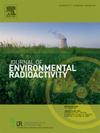量化从加拿大采矿作业到淡水的镭226的历史释放量
IF 2.1
3区 环境科学与生态学
Q3 ENVIRONMENTAL SCIENCES
引用次数: 0
摘要
一个常见的误解是,镭-226 (Ra-226)只由铀矿和铀矿厂排放到接收水中。事实上,在各个部门的采矿废水中定期分析Ra-226。利用根据《加拿大金属和钻石采矿废水条例》报告的数据,对2014-2022年期间矿山废水中的Ra-226排放量进行了评估。最终处理的废水浓度范围为0.2至7800 mBq/L。数据按采矿部门分组为贵金属、贱金属、黑色金属、有色金属、铀矿石或钻石。平均Ra-226浓度最高的是有色金属矿山(51.9 mBq/L),其次是贱金属矿山(31.6 mBq/L)、钻石矿山(23.8 mBq/L)、铀矿山(22.0 mBq/L)、贵金属矿山(15.0 mBq/L)和黑色金属矿山(11.0 mBq/L)。有色金属、贱金属、钻石和铀矿开采部门的平均浓度超过了自然背景浓度的上限(21.7 mBq/L),这是根据萨斯喀彻温省北部的参考数据计算得出的。然而,所有部门的中位数浓度都低于UTL,表明可能受到矿体铀含量变化影响的Ra-226间歇性高释放。这项研究表明,铀矿开采作业最终处理的流出物中Ra-226活性浓度低于其他采矿部门,挑战了铀作业是Ra-226排放主要来源的看法。本文章由计算机程序翻译,如有差异,请以英文原文为准。
Quantifying historical releases of radium-226 from Canadian mining operations to freshwaters
A common misconception is that radium-226 (Ra-226) is released into receiving waters exclusively by uranium mines and mills. In fact, Ra-226 is routinely analyzed in mining effluent across various sectors. Using data reported under the Canadian Metal and Diamond Mining Effluent Regulations, Ra-226 releases from mine effluent were evaluated for the period of 2014–2022. Final treated effluent concentrations ranged from 0.2 to 7800 mBq/L. Data were grouped by mining sector as being either precious metals, base metals, ferrous metal, non-ferrous metals, uranium ore, or diamonds. Mean Ra-226 concentrations were highest for non-ferrous metal mines (51.9 mBq/L), followed by base metal (31.6 mBq/L), diamond (23.8 mBq/L), uranium (22.0 mBq/L), precious metal (15.0 mBq/L), and ferrous metal mines (11.0 mBq/L). Mean concentrations for non-ferrous, base metal, diamond, and uranium mining sectors exceeded the upper tolerance limit (UTL) for natural background concentrations (21.7 mBq/L), calculated using reference data from Northern Saskatchewan. Median concentrations, however, were below the UTL for all sectors, indicating episodic high Ra-226 releases likely influenced by variations in the uranium content of the ore bodies. This study demonstrates that Ra-226 activity concentrations in final treated effluent from uranium mining operations are lower than those from other mining sectors, challenging the perception that uranium operations are the primary source of Ra-226 releases.
求助全文
通过发布文献求助,成功后即可免费获取论文全文。
去求助
来源期刊

Journal of environmental radioactivity
环境科学-环境科学
CiteScore
4.70
自引率
13.00%
发文量
209
审稿时长
73 days
期刊介绍:
The Journal of Environmental Radioactivity provides a coherent international forum for publication of original research or review papers on any aspect of the occurrence of radioactivity in natural systems.
Relevant subject areas range from applications of environmental radionuclides as mechanistic or timescale tracers of natural processes to assessments of the radioecological or radiological effects of ambient radioactivity. Papers deal with naturally occurring nuclides or with those created and released by man through nuclear weapons manufacture and testing, energy production, fuel-cycle technology, etc. Reports on radioactivity in the oceans, sediments, rivers, lakes, groundwaters, soils, atmosphere and all divisions of the biosphere are welcomed, but these should not simply be of a monitoring nature unless the data are particularly innovative.
 求助内容:
求助内容: 应助结果提醒方式:
应助结果提醒方式:


